After Elbrus and Kilimanjaro, I knew I can’t take Aconcagua lightly. At almost 7000m it’s the highest mountain outside of Asia and thus the second highest of the Seven Summits. Working full time, the time I had available for training was very limited. This was before covid hit either, so I actually had to commute to the office too, which is about an hour one way. So what can the man do if he only has so many hours in the day and he needs some sleep too, but training has to be done for Aconcagua?
While finding a professional trainer to get me into shape would’ve been the best, it’s not exactly trivial to find people who know what it takes physically to “stroll up” the highest mountain of South America, and even fewer could tell me how to train for it. So instead of trying to look for a trainer I decided to go my own way (based on what guides recommended me).
This meant that I was carrying weights. All the time. I started this for Elbrus, carrying 10kg weight on my commute every day and up the stairs to the 8th floor office. That’s how I crossed Mt Tanzawa and climbed the Houou mountains as well. After Tanzawa I decided to double the weight. While I respect the Northern Alps enough not to take weights on my autumn climbs there (Jonen range and Yari), I felt confident I could handle it on the routes I picked for Amagi and Otake.
While I didn’t take weights on any more climbs until departing for Aconcagua, half a year of commuting with 20kg in my backpack sure had an effect on what my legs could endure.
I was also going to the gym every workday (except when drinking with coworkers) where I’d do strength training mostly with machines, but twice a week also bench presses, and I’d walk on a stepping machine or treadmill for half an hour to an hour with a 20kg weighted backpack again. Definitely not the most exciting training, but it’s a good way to clear my podcast backlog. I’d also go to a climbing gym 1-2 times a week (bouldering is fun). Furthermore I have a light and short jog every morning just to wake myself up.
In retrospect I think this wasn’t a bad training regime (especially the weight dayhikes) but I’d often push myself way too hard leaving me too exhausted to do anything really or worse, get sick from it. For my next climbs I’ll try to compose a better balanced training based on the book Training for the New Alpinism. The “killer core routine” from the book is pretty much all I can do at home anyway while the gyms are closed due to covid…

